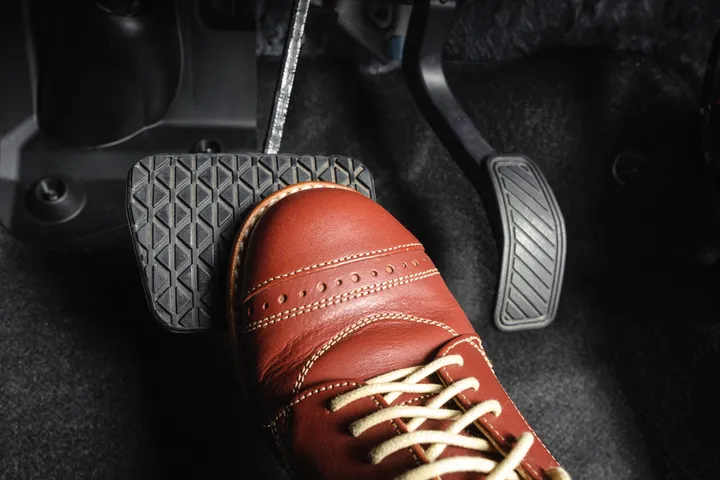


The brake pedal is a critical component of a vehicle's braking system, responsible for initiating the process of slowing down or stopping the car. When the brake pedal experiences issues, it can compromise the overall safety and performance of the vehicle. Understanding common brake pedal problems, their causes, and solutions is essential for every driver.

The brake pedal is the primary interface between the driver and the vehicle's braking system. When you press the pedal, it initiates a series of hydraulic and mechanical processes that ultimately apply the brakes and slow down or stop the vehicle. However, various factors can interfere with this process, leading to brake pedal issues.
| Issue | Description |
|---|---|
| Soft or Spongy Brake Pedal | The pedal feels soft or spongy when pressed, often indicating air in the brake lines, a brake fluid leak, or a worn brake booster. |
| Hard or Stiff Brake Pedal | The pedal feels extremely hard or stiff to press down, which could be caused by a brake booster failure, stuck calipers, or contaminated brake fluid. |
| Pedal Pulsation | The pedal pulsates or vibrates during braking, often indicating warped rotors or uneven pad wear. |
Air in the brake lines
Brake fluid leak
Worn brake booster
Air trapped in the brake lines prevents proper hydraulic pressure buildup, resulting in a spongy pedal feel. Leaks in the brake lines, calipers, or master cylinder can cause a loss of brake fluid, leading to a soft pedal. A worn or faulty brake booster, which assists in applying brake force, can also make the pedal feel spongy.
Brake booster failure
Stuck or seized brake calipers
Contaminated or old brake fluid
A failed brake booster can make the pedal extremely hard to press down, requiring significant force to engage the brakes. Stuck or seized brake calipers can cause uneven brake application, leading to a stiff pedal. Contaminated or old brake fluid can also affect the hydraulic system's performance, making the pedal feel hard.
As a mechanic, diagnosing brake pedal issues is a crucial step in determining the appropriate repair. Here's how I approach it:
Check the brake fluid level and condition: The first step is to inspect the brake fluid level in the master cylinder reservoir. Low fluid levels or discolored fluid can indicate a leak or contamination.
Inspect the brake lines: I carefully examine the brake lines for any leaks, cracks, or damage that could be causing fluid loss or air entry.
Listen for unusual noises: While applying the brakes, I pay close attention to any unusual noises, such as grinding or squeaking, which can indicate caliper issues or worn brake pads.
Check the brake pedal's travel distance and resistance: I press the brake pedal to assess its travel distance and resistance. A pedal that goes all the way to the floor or feels excessively hard or soft can provide valuable clues about the underlying problem.
Perform a brake bleeding procedure: If I suspect air in the brake lines, I perform a proper brake bleeding procedure to eliminate any trapped air and restore proper hydraulic pressure.
Based on the inspection findings, I can often pinpoint the specific issue causing the brake pedal problem:
Soft pedal: If the pedal feels spongy or goes to the floor easily, it may indicate air in the lines or a fluid leak.
Hard pedal: If the pedal is extremely stiff and difficult to press, it could be a sign of a brake booster failure or stuck calipers.
Pedal pulsation: Pulsations in the pedal during braking may indicate warped rotors or uneven pad wear, which can also contribute to brake pedal issues.
Once the root cause of the brake pedal issue is identified, I can proceed with the appropriate repair procedures.
| Repair | Description |
|---|---|
| Bleeding the brakes | Follow the proper bleeding procedure to remove any trapped air from the brake lines and restore proper hydraulic pressure. |
| Replacing brake fluid | If the fluid is contaminated or old, flush the system and replace it with fresh, high-quality brake fluid recommended by the manufacturer. |
| Repairing leaks | Locate and repair any leaks in the brake lines, calipers, or master cylinder using appropriate methods, such as replacing damaged components or tightening fittings. |
| Replacing brake booster | If the brake booster is faulty, replace it with a new one, following the manufacturer's instructions for proper installation and adjustment. |
Replacing brake booster: If the brake booster is the cause of the hard pedal, I replace it with a new one, ensuring proper installation and adjustment.
Servicing calipers: If the calipers are stuck or seized, I disassemble, clean, and lubricate them, or replace them if necessary. This process can be time-consuming but is essential to restore proper brake function.
Flushing brake fluid: If the brake fluid is contaminated, I perform a complete flush of the system and replace it with fresh fluid to ensure optimal performance.
Throughout the repair process, I follow these important tips and precautions:
Follow manufacturer's procedures and torque specifications to ensure proper repair and avoid potential issues.
Use the correct brake fluid type specified for the vehicle to prevent compatibility issues and potential damage.
Perform a thorough brake bleeding procedure after any repair or fluid replacement to ensure there is no trapped air in the system.
Inspect for any other related issues, such as worn brake pads or rotors, and address them accordingly to ensure the braking system is functioning optimally.

While brake pedal issues can be frustrating, there are steps you can take to prevent them from recurring:
Follow the manufacturer's recommended brake fluid change intervals to keep the system in top condition and prevent contamination.
Inspect the brake system components regularly for any signs of wear, damage, or leaks during routine maintenance.
Maintain a clean brake system, free from dirt, debris, and moisture, to prevent corrosion and potential issues.
Avoid riding the brakes or keeping your foot on the pedal unnecessarily, as this can cause premature wear and potential issues.
Allow the brakes to cool down after heavy braking situations, such as descending steep hills or towing heavy loads, to prevent brake fluid from boiling and leading to brake pedal issues.
Avoid driving through deep water or areas with excessive road salt, as exposure to these conditions can cause corrosion and damage to the brake components.
The cost of repairing brake pedal issues can vary depending on the specific cause and the extent of the repair required.
| Repair | Approximate Cost Range |
|---|---|
| Brake bleeding | $80 - $150 (labor cost) |
| Brake fluid flush | $100 - $200 (parts and labor) |
| Brake booster replacement | $300 - $600 (parts and labor) |
| Caliper repair or replacement | $200 - $400 per caliper (parts and labor) |
| Brake line replacement | $150 - $400 (parts and labor) |
It's important to note that these costs can vary based on your vehicle's make and model, the mechanic's labor rates, and any additional repairs required. While the cost of repairs may seem high, it's crucial to address brake pedal issues promptly, as they can significantly impact your vehicle's safety and performance.
Brake pedal issues can be frustrating and potentially dangerous if left unaddressed. As a mechanic, I've seen firsthand the importance of properly diagnosing and repairing these issues to ensure the safety of my customers and their vehicles.
By following regular maintenance schedules, being mindful of proper brake usage, and addressing any issues promptly, you can help prevent recurring brake pedal problems and keep your braking system in top condition.
Remember, your brakes are one of the most critical safety components of your vehicle. If you experience any issues with your brake pedal, don't hesitate to have it inspected by a qualified mechanic. A well-maintained braking system can provide peace of mind and a safer driving experience for you and your loved ones.
A spongy or soft brake pedal is usually caused by air in the brake lines or a brake fluid leak. It indicates a loss of hydraulic pressure in the braking system.
Look for a puddle of clear, light yellow to brown fluid under your car, typically near the wheels or under the brake pedal area. This is a sign of a brake fluid leak.
If brake pads are worn out, the caliper piston has to extend further, causing the brake fluid level to drop and resulting in a low or sinking brake pedal.
A hard brake pedal can be caused by a failed brake booster, a leaking vacuum hose, or extreme brake fluid contamination, making it difficult to press the pedal.
Brake pedal pulsation or vibration is often caused by warped or unevenly worn brake rotors, leading to uneven contact with the brake pads.
Brake fluid should be replaced every 2-3 years or as recommended by the vehicle manufacturer to prevent contamination and maintain proper braking performance.
While basic visual inspections are possible, a comprehensive brake inspection and replacement of components like pads and rotors should be left to professional mechanics to ensure proper diagnosis and installation.
Frequent stop-and-go traffic, excessive braking, and towing heavy loads can accelerate brake pad and rotor wear, shortening their lifespan.
Regular maintenance, keeping brake fluid topped up, proper tire inflation, avoiding excessive braking, and following the manufacturer's service intervals can help extend the life of your brake system.
Signs of a failing brake caliper include a vehicle pulling to one side during braking, a stuck or seized caliper causing excessive pad wear or overheating, and potential brake fluid leaks.

Sarah isn't your average gearhead. With a double major in Mechanical Engineering and Automotive Technology, she dived straight into the world of car repair. After 15 years of turning wrenches at dealerships and independent shops, Sarah joined MICDOT to share her expertise and passion for making cars run like new. Her in-depth knowledge and knack for explaining complex issues in simple terms make her a valuable asset to our team.



